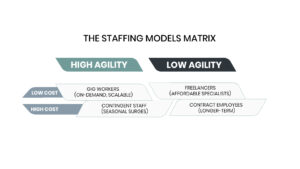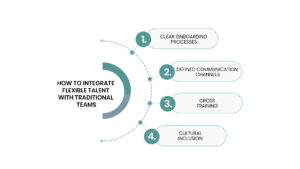The modern workplace is undergoing a dramatic transformation. Traditional full-time employment no longer dominates the labor market as businesses increasingly look for agile and cost-effective workforce management solutions. According to McKinsey, nearly 36% of the U.S. workforce now participates in the gig economy staffing sector in some form, and by 2030, flexible workforce models are expected to account for more than half of all staffing decisions. For mid-sized businesses that often operate with limited budgets but still need to remain competitive, adopting contingent staffing or interim staffing models can be the key to resilience, growth, and long-term sustainability.
In this guide, we’ll explore how flexible workforce models—including freelance, gig, contingent, and contract staffing—are shaping the future of HR. We’ll also demonstrate the benefits for businesses, provide a practical 2×2 staffing model matrix, and offer a real-world mini-case study.
Why Flexible Workforce Models and Workforce Management Solutions Are the Future of HR
The pace of change in today’s economy is unprecedented. From economic uncertainty to rapid technological adoption, organizations must remain agile to survive. Workforce flexibility allows companies to:
- Scale teams up or down based on demand.
- Access specialized skills without long-term overhead.
- Reduce fixed payroll costs while increasing efficiency.
- Build resilience during seasonal or crisis-driven fluctuations.
A Deloitte survey revealed that 79% of business executives consider workforce management solutions and agility as one of the most critical drivers of organizational success. For industries such as healthcare, logistics, IT, and professional services, contingent staffing and interim staffing are no longer optional—they’re essential.
Understanding the Spectrum: Freelance, Gig Economy Staffing, Contingent Staffing, and Contract Roles
Flexible workforce models exist on a spectrum. While often used interchangeably, freelance, gig, contingent, and contract staffing have distinct differences:
- Freelance Staffing: Independent professionals offering specialized skills (e.g., graphic designers, consultants). Engagements are project-based and often remote.
- Gig Staffing: Short-term, task-oriented roles often facilitated by digital platforms (e.g., ridesharing, delivery, event staffing).
- Contingent Staffing: Workers hired temporarily to fill roles, usually through HR staffing services or temp staffing agencies, often for seasonal or project-based staffing needs.
- Contract Staffing: Professionals hired on fixed-term contracts, often for several months, providing consistency with flexibility at the end of the engagement.
The Staffing Models Matrix: Comparing Flexible Workforce Models for Business Agility
To better visualize the options, here’s a 2×2 matrix comparing staffing types by cost (low vs. high) and agility (low vs. high):

This framework helps HR leaders determine the best fit for their workforce needs while balancing budget and adaptability with recruitment process outsourcing (RPO solutions) or vendor management system (VMS solutions) integrations.
Key Benefits of Flexible Staffing Models for Mid-Sized Businesses Using HR Staffing Services
Mid-sized businesses often face a unique challenge: they need the talent depth of larger corporations but must manage resources more carefully than enterprise competitors. Flexible workforce models offers several advantages:
- Cost Efficiency – Instead of carrying the overhead of full-time salaries and benefits, businesses can allocate funds more strategically by hiring talent only when required through payrolling services or corporate payroll services.
- Access to Expertise – Specialized skills, such as IT cybersecurity or digital marketing, can be accessed on-demand without long-term commitments through executive recruiters or managed service provider staffing.
- Risk Mitigation – Contingent staffing reduces risk during uncertain times, such as economic downturns or sudden demand spikes.
- Improved Workforce Resilience – By diversifying HR staffing services and staffing models, companies are less vulnerable to disruptions and can adapt more quickly.
For example, a retail company preparing for the holiday rush can engage contingent staffing for seasonal demand, while maintaining a lean core workforce for the rest of the year.
How to Integrate Flexible Talent with Permanent Staffing and Traditional Teams
Bringing in gig economy staffing workers or contractors is only half the battle. The real value lies in integration with your core teams. Here are key steps for smooth assimilation:

- Clear Onboarding Processes – Provide freelancers and contingent staff with a streamlined onboarding guide that includes company values, communication protocols, and role expectations.
- Defined Communication Channels – Ensure all team members, whether full-time or temporary, have access to the same collaboration tools and project management platforms.
- Cross-Training – Encourage knowledge sharing between permanent employees and project-based staffing resources to foster continuity.
- Cultural Inclusion – Treat temporary workers as valued team members by including them in team meetings, celebrations, and recognition programs.
When done correctly, interim staffing and temp-to-hire staffing not only supports immediate business needs but also strengthens organizational culture and team cohesion.
Conclusion: Building Workforce Resilience with Flexible Workforce Models and Interim Staffing
Workforce resilience is no longer just a “nice to have”—it is essential for long-term growth. Flexible workforce models allow organizations to stay lean, agile, and ready to face disruptions without sacrificing performance. By strategically leveraging freelance, gig, contingent staffing, and interim staffing, businesses can achieve a balance between cost efficiency and operational agility.
For mid-sized businesses, embracing flexibility doesn’t just solve today’s staffing challenges—it future-proofs the organization against tomorrow’s uncertainties.
Ready to build a more resilient workforce? Discover how Interim HR Consulting can help you design tailored workforce management solutions, strengthen your team and position your business for growth.
Visit Interim HR Consulting today
FAQs on Contingent Staffing, Project-Based Staffing, and Workforce Management Solutions
Q1: What is the difference between gig, freelance, and contingent staffing?
- Gig staffing involves short-term, task-based work, often mediated through platforms.
- Freelance staffing refers to independent professionals offering specialized skills for projects.
- Contingent staffing typically involves workers hired temporarily via HR staffing services or temp staffing agencies to fill seasonal or project-based staffing roles.
Q2: How can one organization benefit from flexible workforce models?
Organizations can scale their workforce on-demand, access specialized skills, reduce overhead costs, and strengthen resilience during economic or seasonal shifts. Flexible workforce models and RPO solutions allow mid-sized businesses to remain competitive against larger corporations.
Q3: What are the steps to integrate gig workers into existing teams?
The steps include providing clear onboarding, establishing communication channels, fostering inclusion in company culture, and encouraging cross-training with full-time employees. This ensures smooth collaboration and productivity with both permanent staffing and temp-to-hire staffing roles.
